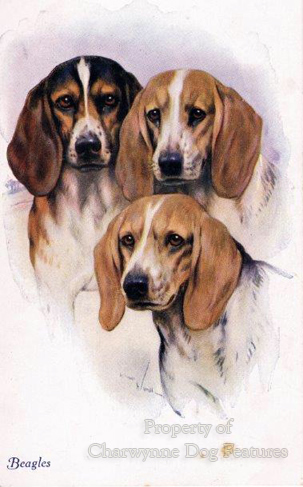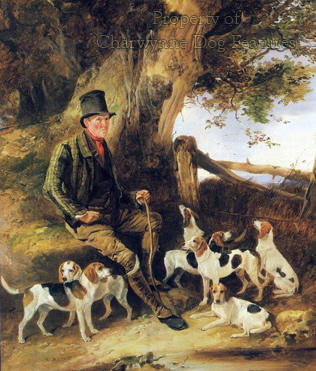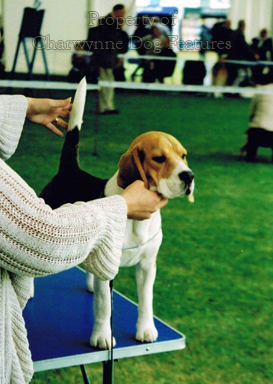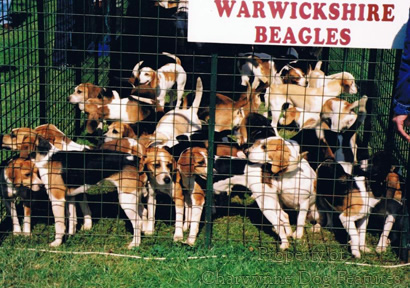795 Beagles on Show
Beagles On Show
by David Hancock
 The differing needs of those who hunt Beagles and those who only show them has led to the production of two different hounds. Breed type is sometimes over-played by the show fraternity; the requirements of the pack, and purely function can produce plain-headed, lightweight hounds with more ‘hounds general’ than pedigree Beagle in their appearance. This dilemma is hardly new. Writing in the Beagle Club’s Yearbook for 1901, Walter Crofton gave the view: “The fact is, Peterborough, supported by Masters keeping Beagles for hare-hunting and catering only for such, has for some years encouraged the breeding and showing of well-made speedy little hounds and altogether neglected some of the beautiful and typical head points of the Beagle, and with these have gone a few of his working characteristics. On the other hand, the country gentleman and farmer (sometimes for generations) has kept in the family a little ‘cry’ of Beagles for shooting over, has bred to maintain the style of work he admires, and the typical Beagle expression and head, which he loves, but he has often been careless about body parts…” It must be the aim to breed for function without losing the breed. It’s quite possible to ‘lose the breed’ in the packs but more likely in the show ring.
The differing needs of those who hunt Beagles and those who only show them has led to the production of two different hounds. Breed type is sometimes over-played by the show fraternity; the requirements of the pack, and purely function can produce plain-headed, lightweight hounds with more ‘hounds general’ than pedigree Beagle in their appearance. This dilemma is hardly new. Writing in the Beagle Club’s Yearbook for 1901, Walter Crofton gave the view: “The fact is, Peterborough, supported by Masters keeping Beagles for hare-hunting and catering only for such, has for some years encouraged the breeding and showing of well-made speedy little hounds and altogether neglected some of the beautiful and typical head points of the Beagle, and with these have gone a few of his working characteristics. On the other hand, the country gentleman and farmer (sometimes for generations) has kept in the family a little ‘cry’ of Beagles for shooting over, has bred to maintain the style of work he admires, and the typical Beagle expression and head, which he loves, but he has often been careless about body parts…” It must be the aim to breed for function without losing the breed. It’s quite possible to ‘lose the breed’ in the packs but more likely in the show ring. 
Exhibiting Faults
At the final championship show of 2012, the Ladies Kennel Association’s, the Beagle judge was commendably honest in her remarks about the entry. Although the prevalent faults she found are hardly new, it was of value to persist in drawing attention to them. Flat and splayed feet are a handicap to a running hound, the breed standard requires them to be ‘tight and firm’. The commonest cause of such a flaw is a lack of hard exercise; hounds of any breed put before a judge should be in the very best condition. Tails curling over the back, spitz-fashion, spoil an otherwise sound exhibit and this judge was right to resent it. But it has been a long-standing fault in this breed – I can remember seeing it 50 years ago. Show breeders have habitually blamed the packs for this, but I see few signs of it there. 
The first show Beagle I ever saw, in the 1950s, was an outstanding hound, Ch Barvae Paigan and he came from the pack bloodlines. I was also impressed by a very sound show dog, Glenivy Intrepid, a decade or so ago, really looking like a hare-hound. In recent years, from the ringside, I have been impressed by Ch Nedlaw Barbarian, a wonderfully symmetrical little hound. But show Beagles have, for me, too heavy a body, their legs are too hefty and their feet too large for my liking; the latter may not be helped by a breed standard that specifies feet that are ‘well knuckled-up’ and ‘not hare-footed’. This may be rooted in the distant past when such standards were first written. The Foxhound breeders have moved on; let’s hope we don’t have a ‘mini-shorthorn tendency’ in this fine breed. It was depressing to read the critique of the Beagle judge at the Scottish Beagle Club’s show in April 2008: “Front movement coming on was as bad as I can ever remember, many hounds had large open feet, far too many had short ribcages and long loins…” Did the exhibitors of such hounds truly not know what made a sound Beagle?
Shoulders and Size
There seems to be an endless debate about shoulder height in Beagles. Writing in Hounds magazine in November 1987, Beagle expert Newton Rycroft gave the view that: “Height alone does not govern pace in beagles. Shoulders and stride are also most important.”, going on to describe how one of the smallest bitches in kennels often performed best in the field because she was the only one with perfect shoulders. He finished his article by stating: “Finally, the 16-17 (inch) beagle. Rightly or wrongly those who breed these get little sympathy from this quarter! If they cannot catch hares with 15 inch beagles then I feel they need not bigger hounds, but better ones.” A reader subsequently wrote in to state that after a mating that produced exceptional quality at 14 inches, a repeat mating produced a litter of five, all over 16 inches. Do you cull quality because of shoulder height? In another issue of the same magazine, ‘Hareless’ was stating “Reduce your size down to 14/15 inch? Well. fine in the lowlands, but too small for a rough moorland country. Quality fifteen inch beagles can soon lose their followers on the right day, but as long as they turn with their hare and retain a god cry do not be put off by the grumblers. It seems illogical to spend ten to fifteen years breeding your hounds to perfection, then start taking notice of people who say they are too good.” I do wish the breeders of show Beagles would take more notice of those who breed the hunting hounds.
(David Hancock's latest book Hounds - Hunting by Scent is being published by Crowood in 2014)